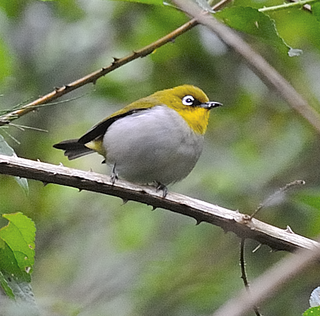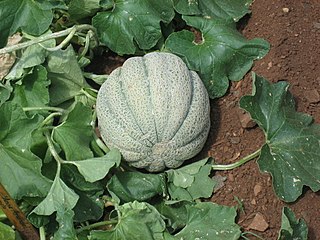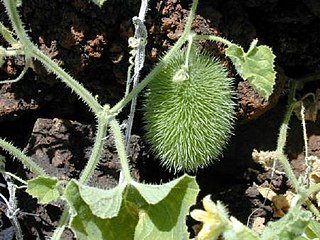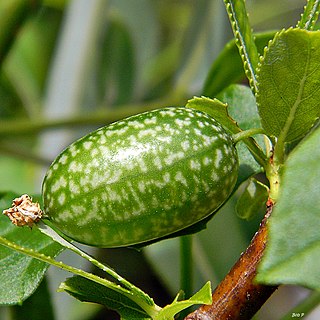
The Cucurbitaceae, also called cucurbits or the gourd family, are a plant family consisting of about 965 species in 101 genera. Those of most agricultural, commercial or nutritional value to humans include:

The cucumber is a widely-cultivated creeping vine plant in the family Cucurbitaceae that bears cylindrical to spherical fruits, which are used as culinary vegetables. Considered an annual plant, there are three main types of cucumber—slicing, pickling, and seedless—within which several cultivars have been created. The cucumber originates in Asia extending from India, Nepal, Bangladesh, China, and Northern Thailand, but now grows on most continents, and many different types of cucumber are grown commercially and traded on the global market. In North America, the term wild cucumber refers to plants in the genera Echinocystis and Marah, though the two are not closely related.

A melon is any of various plants of the family Cucurbitaceae with sweet, edible, and fleshy fruit. The word "melon" can refer to either the plant or specifically to the fruit. Botanically, a melon is a kind of berry, specifically a "pepo". The word melon derives from Latin melopepo, which is the latinization of the Greek μηλοπέπων (mēlopepōn), meaning "melon", itself a compound of μῆλον (mēlon), "apple", treefruit " and πέπων (pepōn), amongst others "a kind of gourd or melon". Many different cultivars have been produced, particularly of cantaloupes.

Cucumis is a genus of twining, tendril-bearing plants in the family Cucurbitaceae which includes the cucumber, true melons, the horned melon, and the West Indian gherkin.

Cucumis anguria, commonly known as maroon cucumber, West Indian gherkin, maxixe, burr gherkin, cackrey, and West Indian gourd, is a vine that is indigenous to Africa, but has become naturalized in the New World, and is cultivated in many places. It is similar and related to the common cucumber (C. sativus) and its cultivars are known as gherkins.

The Armenian cucumber, Cucumis melo Flexuosus Group or Cucumis melo var. flexuosus, is a type of long, slender fruit which tastes like a cucumber and looks somewhat like a cucumber inside. It is actually a variety of true melon, a species closely related to the cucumber. It is also known as the yard-long cucumber, snake cucumber, snake melon, Varunk in Armenian, chanbar in Persian, sheng in Semnani, chirimenhosonagauri in Japanese, acur in Turkish, kakadee in Hindi, tar in Punjabi, قثاء in Arabic, commarella or tortarello in Italian. It should not be confused with the snake gourds. The skin is very thin, light green, and bumpless. It has no bitterness and the fruit is almost always used without peeling. It is also sometimes called a gutah.

Cucumis myriocarpus, the gooseberry cucumber, gooseberry gourd, paddy melon, Mallee Pear or prickly paddy melon, is a prostrate or climbing annual herb native to tropical and southern Africa. It has small, round, yellow-green or green-striped fruit with soft spines, small yellow flowers and deeply lobed, light green leaves. The melon occurs in disturbed soil and cleared or bare areas, and thrives on summer moisture.

The Malagasy white-eye is a species of bird in the white-eye family, Zosteropidae. Found in Madagascar and Seychelles, its natural habitats are subtropical or tropical dry forests, subtropical or tropical moist lowland forests, subtropical or tropical mangrove forests, and subtropical or tropical moist montane forests.

Cucurbitacins are a class of biochemical compounds that some plants – notably members of the pumpkin and gourd family, Cucurbitaceae – produce and which function as a defense against herbivores. Cucurbitacins and their derivatives have also been found in many other plant families, in some mushrooms and even in some marine mollusks.

Cucumis melo, also known as melon, is a species of Cucumis that has been developed into many cultivated varieties. The fruit is a pepo. The flesh is either sweet or bland, with or without an aroma, and the rind can be smooth, ribbed, wrinkled, or netted. The species is sometimes referred to as muskmelon, but there is no consensus about the usage of this term, as it can also be used as a specific name for the musky netted-rind American cantaloupe, or as a generic name for any sweet-flesh variety such the inodorous smooth-rind honeydew melon.
Paddy melon is a common name for two species of plants in the melon family which are invasive in Australia:

The oriental melon, is a group of Cucumis melo cultivars that are produced in East Asia. Phylogenetic studies tracing the genetic lineage of the plant suggest that it may have originated in eastern India, having then spread to China over the Silk Road, from which it was introduced to Korea and Japan. Its flavour has been described as a cross between a honeydew melon and a cucumber. It is noticeably less sweet than Western varieties of melon, and consists of about 90% water. The fruits are commonly eaten fresh; with its thin rind and small seeds, the melon can be eaten whole.
Cucumis althaeoides is a vine in the family Cucurbitaceae that is native to parts of Northern Australia.

Cucumis dipsaceus, also known as Arabian cucumber or hedgehog cucumber, is an annual climbing herb that can be found in tropical and arid locations. The plant is native to eastern Africa, first found in Sudan, southern Egypt, and Ethiopia. The developed fruits of the plant change from green to yellow and contain many seeds. The hairs that cover the oblong fruits nickname this species the “hedgehog cucumber”.

Melothria is a genus of flowering plants in the family Cucurbitaceae, native to the Americas from the United States to Argentina, and with some introductions in Africa and elsewhere. A number of Old World species formerly in Melothria were reassigned to Cucumis.

Cucumis prophetarum is a dioecious and prostrate or climbing perennial vine in the family Cucurbitaceae. The specific epithet (prophetarum) comes from Latin propheta, meaning "prophet".
Andromonoecy is a breeding system of plant species in which male and hermaphrodite flowers are on the same plant. It is a monomorphic sexual system comparable with monoecy, gynomonoecy and trimonoecy. Andromonoecy is frequent among genera with zygomorphic flowers, however it is overall rare and occurs in less than 2% of plant species. Nonetheless the breeding system has gained interest among biologists in the study of sex expression.
Cyperus maderaspatanus is a species of sedge that is native to parts of eastern Africa and India.

















